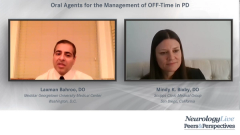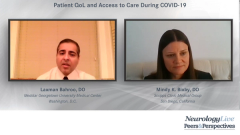
Oral Agents for the Management of OFF Time in PD
Expert neurologists consider the advantages and disadvantages of oral agents for OFF time in Parkinson’s Disease such as opicapone, extended-release amantadine, and istradefylline.
Episodes in this series

Laxman Bahroo, DO: We are gonna switch gears and talk about other medications that are in the OFF episode space, though these are oral medications. This an interesting point to consider. The on-demand medications that bypass the gut are the ones we’ve discussed so far. These are oral medications that have been indicated for OFF episodes. But as we talk about it, the data really talk about OFF time, not necessarily OFF episodes as indicated by the FDA. First, we are going to talk about opicapone oral capsules.
Opicapone is a once-a-day COMT inhibitor. The trade name for this Ongentys. It is an interesting medication because it blocks COMT much more robustly than what we are used to. It reduces the pulsatility of the COMT blockade that we have with previous COMT inhibitors. It is once a day, and its adverse-effect potential is very different. It does not have the diarrhea and the coloration of the urine that we see with other medications. Dr Bixby, what do you see as the main advantages or disadvantages of this medication?
Mindy Bixby, DO: Great question. It has been more effective. One, patients do not like to take more pills. They already are taking so much sometimes based on how much they need. If you can take a medication once a day, and it protects you throughout the day for a better on time, then you more likely will take this medication instead of others. That is the difference between this 1 and the other COMT inhibitors. Two, the medication is a different molecule, so it may be more advantageous to try this compared with taking something every time you take carbidopa, levodopa, or a dopamine product, which is wonderful. Three, it is brilliant in the way of understanding how well the mechanism is different. It’s a higher affinity. It is really helped the opportunity of the first-pass problem that we have a lot of times, which is trying to get as much dopamine into the system as we can and half of it or more is taken up and metabolized into other areas. The beauty of it is that I do like this mechanism because it helps patients have more on-time, giving them more opportunity to have the medication work better by taking 1 additional tablet. That is quite easy to manage.
Laxman Bahroo, DO: You are spot on with many of these points. It’s important to have a once-a-day medication. Patients certainly want fewer pills. They’re already taking so much, plus for other medical conditions. The main advantage is the longer-term blockade. What’s interesting about their data is that they’re out of Europe. The studies are BIPARK-1 and BIPARK-2. Because these are European data, it’s interesting that they’re compared with not just placebo but also entacapone. They showed a better reduction of OFF time and an improvement of on-time without troublesome dyskinesias. That was better than in the double-blinded phase than the entacapone arm, and you saw sustained response where individuals didn’t need to adjust their levodopa for the better part of the year.
In fact, the main adverse effect was really dyskinesia, and not as much orthostasis or other things that we’re used to seeing and certainly not diarrhea, which is surprising for people who are used to using previous-generation COMT inhibitors. What’s interesting is that with dyskinesia being the main adverse effect, it got better as people adjusted their levodopa dosing downward. That’s been my experience in my practice as well. We’ve done that, and it’s been helpful. It comes in 2 different doses. It’s hepatically metabolized, so 50 mg is the main dose for people with normal or mild hepatic impairment. I have some folks at 25 mg who found the 50 mg to be a little too powerful.
Mindy Bixby, DO: The beauty of it is that imagine that you can decrease the levodopa load by giving them this and keeping that at bay. Because there is a maximum amount of medication that you can use of levodopa over time for a lot of reasons. What a wonderful opportunity for a patient to be able to lower their dose. It makes them feel even better. A lot of them are like, “I’m going up on it. I’m going up again,” and they get worried that their disease is getting much worse. If we can change that motivation and allow them to understand that this may be helpful for them and they go down on their dose, it is a beautiful thing.
So, they feel, “I can do this, and I’m not having much dopamine on board.” Overall, that’s how I deal with the dyskinesia: “We can go a little lower on the dose. You just need a little modulation of this medication with levodopa, so you can lower your dose and feel better.” The beautiful thing about this medication is that it’s once a day. But a lot of times, people do quite well with this without treating additional adverse effects.
Laxman Bahroo, DO: Absolutely. Let us switch gears and talk about amantadine extended-release tablets, also known as Gocovri. Amantadine extended-release capsules have a unique mechanism of action. Amantadine is not a predominant dopaminergic medication. It is an antiglutaminergic medication acting on the NMDA receptors. Of course, we have had amantadine around for as long as you can imagine, even longer than levodopa in many ways. But what is interesting here is that the extended-release formulation, when it first came to market, was as an antidyskinesia. The indication was for levodopa-induced dyskinesia, which was a unique indication. But just this year it received a second indication for OFF episode. That is an interesting component, that a medication is indicated for dyskinesia reduction and OFF episode reduction. What are the main advantages and disadvantages for this medication?
Mindy Bixby, DO: It has been great. I am so excited about having this drug simply because amantadine immediate-release formula is up to 3-times-a-day dosing, for 1. Additionally, it is immediate release, so it kicks in and then kicks off. Therefore, it is always up, down, up, down. Two, you take it at night, and it slowly builds up in your system, so in the morning, you are on again. They do not have to feel that OFF period of offering medication. It is an interesting thing, and it works for 24 hours. The next thing I like about the medication is that I have noticed that patients have a lot more on time. The indication has been wonderful. I saw that before they got the indication. That is a good thing. When patients come in, a lot of times they will want to treat their dyskinesias. But they also say, “That means more carbidopa, levodopa.” If I can give them something that would do 2 things and help them moving forward, it is fantastic.
With Gocovri, that’s been quite effective. There are some disadvantages; amantadine itself can create hallucinations. Have I seen this with controlled release and immediate release? I have in my practice, which has been effective and helpful for me. Other than that, the dosing for the medication is at night, and in the morning, they wake up and they feel on. As we talked about, for the morning OFF periods, maybe we’ll be able to help those patients with that, so you don’t need to take any additional medication for a rescue. Gocovri has that, and Gocovri kicks in when you wake up. That’s amazing.
Laxman Bahroo, DO: Those advantages and disadvantages are very nicely stated. The data that we saw in the EASE LID and EASE LID 3 studies are very important. We saw robust dyskinesia reduction. I always thought of this as a dyskinesia medication, but if you look at the data in EASE LID and the time studies, you can also see a reduction in OFF, and that’s important. It’s different for us to think that a medication gives us not only dyskinesia control but also OFF control. We’re so used to thinking of 1 or the other, and medications that are used for OFF increased likelihood of developing dyskinesias. Here’s a medication that really modulates it. Maybe the unique mechanism of action allows that. It’s interesting from that point of view.
Let’s talk about istradefylline. Istradefylline is called Nourianz, and its mechanism of action is completely different. We’re moving away from dopaminergic mechanism of actions. We’re talking about an adenosine 2A receptor antagonist. Adenosine receptors, of course, are seen in the basal ganglia A2A receptors. They don’t work on the direct pathways. Many of the medications we’re talking about are dopaminergic and work on the direct pathway that promotes movement. Here, we’re talking about an indirect pathway where we’re reducing the overactivity of the indirect pathway, which is reducing movement. Therefore, it’s really coming at OFF from a different target. What do you think are the advantages and disadvantages?
Mindy Bixby, DO: There are so many. The different mechanism of action is going to a different opportunity to see an improvement in a different pathway to modulate and help those patients. We have always looked at, “Get back dopamine. Get back dopamine,” to somehow give a supplementation to give that dopamine back. Now we are understanding a little more about the mechanisms of the disease. Notably, with what is happening moving forward, you’ve got your toxicity of some things, and there are not enough opportunities for others. So, dopamine has always been the gold standard.
Give back dopamine some way, somehow. But we are looking at other mechanisms that may be able to modulate, so they will not have to need so much dopamine that you are on. Regarding the indirect pathways, there is so much more to learn about. But this medication has been quite effective in helping give away the receptor burden because you have an indirect pathway. At this point, it is being used for OFF periods to see if we can improve those OFF periods. I would like to see what happens in the future. There may be a different opportunity for it to be used by itself. That would be helpful for new patients who are just starting to see some of their symptoms of Parkinson disease.
Laxman Bahroo, DO: Absolutely. The nondopaminergic modulation is an exciting target. So far, we have grown up in the dopaminergic era. Before us preceded some nondopaminergic usage of medications, but we have grown up in the heyday of the dopaminergic era, so we can complement our therapies with dopaminergics and nondopaminergics. The medication has been available in Japan much longer than here, so there are 4 studies for it, looking at the 20- and 40-mg dose. The niche for me is individuals who are already on multiple dopaminergic medications still experiencing OFFs. I tell them, “Let’s do this in a different pathway.” Of course, the adverse-effect profile supports that the main adverse effect is dyskinesia. But realistically, we do not see some of the other dopaminergic adverse effects of nausea and orthostasis. That is an interesting target.
Mindy Bixby, DO: I agree. Absolutely.
Laxman Bahroo, DO: Thank you for watching this NeurologyLive® Peers & Perspectives. If you enjoyed the content, please subscribe to the e-newsletters to receive upcoming programs and other great content in your in-box.
Transcript Edited for Clarity
Newsletter
Keep your finger on the pulse of neurology—subscribe to NeurologyLive for expert interviews, new data, and breakthrough treatment updates.



















































